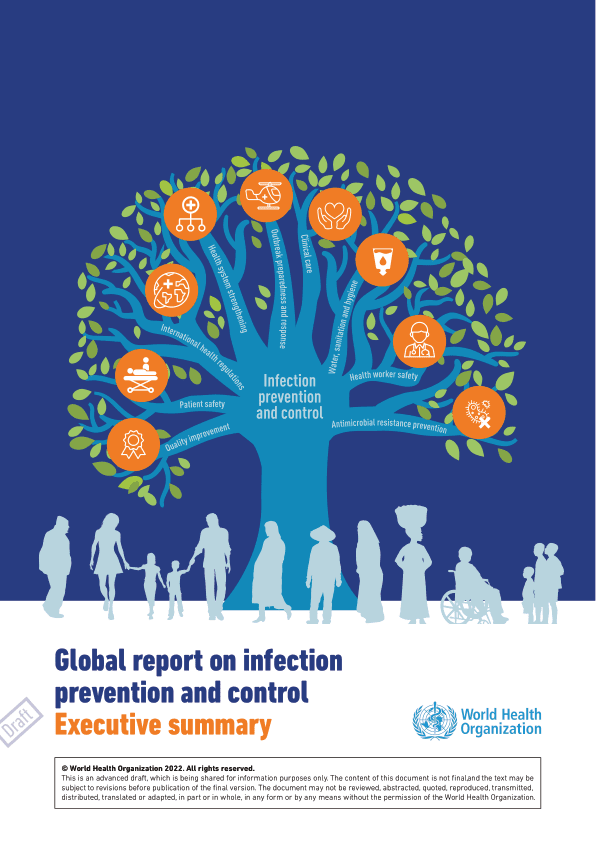Reveals that good IPC programmes can reduce health care infections by 70%
WHO
Geneva, 6 May 2022
The COVID-19 pandemic and other recent large disease outbreaks have highlighted the extent to which health care settings can contribute to the spread of infections, harming patients, health workers and visitors, if insufficient attention is paid to infection prevention and control (IPC).
But a new report from the World Health Organization (WHO) shows that where good hand hygiene and other cost-effective practices are followed, 70% of those infections can be prevented.
The COVID-19 pandemic and other recent large disease outbreaks have highlighted the extent to which health care settings can contribute to the spread of infections,… a new report from WHO shows that where good hand hygiene and other cost-effective practices are followed, 70% of those infections can be prevented.
Today, out of every 100 patients in acute-care hospitals, seven patients in high-income countries and 15 patients in low- and middle-income countries will acquire at least one health care-associated infection (HAI) during their hospital stay.
On average, 1 in every 10 affected patients will die from their HAI.
Today, out of every 100 patients in acute-care hospitals, seven patients in high-income countries and 15 patients in low- and middle-income countries will acquire at least one health care-associated infection (HAI) during their hospital stay.
On average, 1 in every 10 affected patients will die from their HAI.
People in intensive care and newborns are particularly at risk.
And the report reveals that approximately one in four hospital-treated sepsis cases and almost half of all cases of sepsis with organ dysfunction treated in adult intensive-care units are health care-associated.
People in intensive care and newborns are particularly at risk.
And the report reveals that approximately one in four hospital-treated sepsis cases and almost half of all cases of sepsis with organ dysfunction treated in adult intensive-care units are health care-associated.
Today, on the eve of World Hand Hygiene Day, WHO is previewing the first ever Global Report on Infection Prevention and Control which brings together evidence from scientific literature and various reports, and new data from WHO studies.
“The COVID-19 pandemic has exposed many challenges and gaps in IPC in all regions and countries, including those which had the most advanced IPC programmes,” said Dr Tedros Adhanom Ghebreyesus, WHO Director General.
“It has also provided an unprecedented opportunity to take stock of the situation and rapidly scale up outbreak readiness and response through IPC practices, as well as strengthening IPC programmes across the health system.
Our challenge now is to ensure that all countries are able to allocate the human resources, supplies and infrastructures this requires.”
The new WHO report provides the first-ever global situation analysis of how IPC programmes are being implemented in countries around the world, including regional and country focuses.
While highlighting the harm to patients and healthcare workers caused by HAIs and antimicrobial resistance, the report also addresses the impact and cost-effectiveness of infection prevention and control programmes and the strategies and resources available to countries to improve them.
The impact of healthcare associated infections and antimicrobial resistance on people’s lives is incalculable.
- Over 24% of patients affected by health care-associated sepsis and
- 52.3% of those patients treated in an intensive care unit die each year.
- Deaths are increased two to threefold when infections are resistant to antimicrobials.
The impact of healthcare associated infections and antimicrobial resistance on people’s lives is incalculable.
(1) Over 24% of patients affected by health care-associated sepsis and (2) 52.3% of those patients treated in an intensive care unit die each year. (3) Deaths are increased two to threefold when infections are resistant to antimicrobials.
In the last five years, WHO has conducted global surveys and country joint evaluations to assess the implementation status of national IPC programmes.
Comparing data from the 2017–18 and the 2021–22 surveys, the percentage of countries having a national IPC programme did not improve; furthermore in 2021–22 only four out of 106 assessed countries (3.8%) had all minimum requirements for IPC in place at the national level.
This is reflected in inadequate implementation of IPC practices at the point of care, with only 15.2% of health care facilities meeting all of the IPC minimum requirements, according to a WHO survey in 2019.
… only 15.2% of health care facilities meeting all of the IPC minimum requirements, according to a WHO survey in 2019.
However, encouraging progress has been made in some areas, with a significant increase being seen in the percentage of countries
- having an appointed IPC focal point,
- a dedicated budget for IPC and curriculum for front-line health care workers’ training;
- developing national IPC guidelines and a national programme or plan for HAI surveillance;
- sing multimodal strategies for IPC interventions; and
- establishing hand hygiene compliance as a key national indicator.
Many countries are demonstrating strong engagement and progress in scaling-up actions to put in place minimum requirements and core components of IPC programmes.
Progress is being strongly supported by WHO and other key players.
Sustaining and further expanding this progress in the long-term is a critical need that requires urgent attention and investments.
The report reveals that high-income countries are more likely to be progressing their IPC work, and are eight times more likely to have a more advanced IPC implementation status than low-income countries.
Indeed, little improvement was seen between 2018 and 2021 in the implementation of IPC national programmes in low-income countries, despite increased attention being paid generally to IPC due to the COVID-19 pandemic.
WHO will continue to support countries to ensure IPC programmes can be improved in every region.
WHO is calling on all countries around the globe to increase their investment in IPC programmes to ensure quality of care and patient and health workers’ safety.
This will not only protect their populations, increased investment in IPC has also demonstrated to improve health outcomes and reduce health-care costs and out-of-pocket expenses.
WHO is calling on all countries around the globe to increase their investment in IPC programmes to ensure quality of care and patient and health workers’ safety.

Overview
This document provides a detailed summary of the content of the WHO global report on infection prevention and control (IPC). It includes a global situation analysis of how IPC programmes are being implemented in countries around the world, according to evidence from the scientific literature and various reports, and new data from WHO studies. It also highlights the harm to patients and health workers caused by health care-associated infections and antimicrobial resistance, addresses the impact and cost-effectiveness of IPC programmes and the strategies and resources available to countries to improve them. Primarily, this document targets those in charge of making decisions and formulating policies in the field of IPC at the national, subnational and facility levels.
Related links Global report on infection prevention and control
Originally published at https://worldhealthorganization.cmail20.com.
Names mentioned
Dr Tedros Adhanom Ghebreyesus, WHO Director General.












